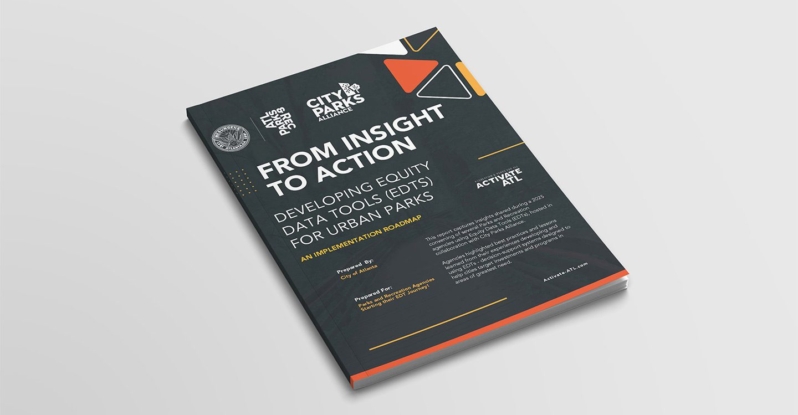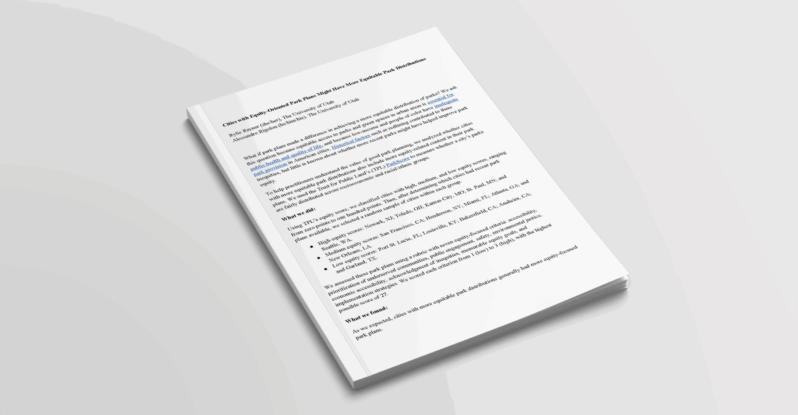Key Findings:
- Pushing limits during the design process attracts donors as well as high profile artists/designers, and creates exciting places.
- Flexible planning and management must adapt to changing budgets, visions, and expectations.
- Presenting the park publically as a gift from the city and patrons creates an environment conducive to fundraising.
- Phased opening of park elements can garner much needed public support mid-way through park completion when construction costs are mounting.
- Creation of a contractually separate entity to manage projects supported by private donors is necessary for securing their active participation and support.
- Innovative park and public art projects can cause a major increase in property and sales tax revenue, stimulate real estate development, attract tourists, and boost local businesses.
- Underground parking structures beneath a city park can provide needed downtown parking and be leased to offset the cost of park construction.
Organization Description
Under Richard M. Daley, the City of Chicago Mayor’s Office initially acquired the land for Millennium Park. In order to engage the private sector, Mayor Daley turned to John H. Bryan (a well-connected philanthropist) who formed the not-for-profit Millennium Park, Inc. This public-private partnership formed the basic fundraising and management structure to create Millennium Park. One of the key factors in this project’s success was the freedom given to patrons of Millennium Park, Inc. to alter the city’s original design and work closely with the park features’ various artists and architects. Even as these changes led to increased construction costs for city-funded portions of the park, the project endured media criticism and political pressures. This would not have been possible without clear contractual separation from the city and adaptive project management by Edward Uhlir in the Mayor’s office. In the end, this partnership successfully raised $490 million to complete the park, a sum that would not have been possible without access to both public and private funding sources.
Project Partners
- Chicago Department of Transportation
- Chicago Department of Cultural Affairs
- Grant Park Conservancy
- Friends of the Park
- Art Institute of Chicago
- Private donors
- Various artists, architects, and landscape architects
Program Description
Chicago’s Grant Park was established in 1844 to be the city’s primary recreational amenity and cultural center. However, in 1852 portions of the parkland were swapped to the Illinois Central Railroad Company (ICR) in exchange for construction of a breakwater on Lake Michigan. These tracks in the park’s northwest corner remained an eyesore- dividing Chicago’s Loop district from the waterfront until 1996 when the City filed a lawsuit against ICR to regain control of this land for development as Millennium Park. The Mayor’s office initially proposed the construction of a parking garage with a landscaped green roof and a new home for the Grant Park Music Festival. This initial proposal required $120 million from parking revenue bonds and $30 million from private sources and was projected to open in mid-2000. In order to attract private donors, Millennium Park Inc. was established by John H. Bryan, who transformed the project’s vision. In exchange for expanding the size of Millennium Park and allowing additional amenities financed and designed primarily by the private sector, he aimed to raise far more than the expected $30 million.
As various architects and artists were hired to design the park’s features, escalating costs led to changes in management, timing, and financing. In June 2000, a disagreement over change order costs led the city to fire the original general contractor, and the project’s growing complexity caused the Public Buildings Commission to replace the Department of Transportation as public project overseer in July 2000. Also, the project’s expanded scope pushed back completion beyond the original mid-2000 date until mid-2004. In order to temper media criticism, the ice rink was opened in mid-2001. The need for financial restructuring caused Mayor Daley to invest Tax Increment Financing (TIF) funds and a termination fee collected from Bear Sterns to pay off the parking revenue bonds. This enabled the city to eventually privatize the parking structures in 2007 and collect roughly $560 million for their 99-year lease.
One of the key factors in Millennium Park’s popularity lies in the fact that it provides a critical mass of attractions for both citizens and tourists. The McDonalds Cycle Center provides heated bicycle parking, showers, lockers, and food to daily commuters. The Cloud Gate Sculpture, a giant polished stainless steel “Bean” attracts visitors from around the world to enjoy warped reflections of Chicago’s skyline and the visitors passing underneath. The Boeing Galleries offer outdoor space for rotating art exhibitions. The Pritzker Pavilion hosts the Grant Park Music Festival and other performances in a state-of-the-art venue for up to 11,000 people. The Chase promenade accommodates exhibitions, fairs, and festivals year round. The Crown Fountain features two fifty-foot tall glass towers that spray water from the projected faces of Chicago citizens onto a large handicap accessible ¼ inch deep water platform. The four Exelon Pavilions generate solar power to offset the parks electrical utility costs. The Harris Theater for Music and Dance is Chicago’s premier indoor venue for small to mid-sized performance groups. The Lurie Garden provides a 5-acre green space with over 138 varieties of plants. The McCormick Tribune Plaza and Ice Rink provides free public skating from November to March and hosts culinary events in the summer. All of these are located atop a renovated train depot and 4,000-car capacity parking garage.
Program Goals
- Transform commuter railroad tracks in Grant Park’s northwest corner into a landscaped venue for free public programming
- Create a permanent home for the Grant Park Music Festival
- Provide one-of-a-kind public art and architecture as a gift to the citizens of Chicago
- Lay the foundation for future residential and commercial development in the area
Timeframe (planning/execution)
1997– The Illinois Central Railroad donates its rights, title, and interest for Millennium Park’s future site to the City of Chicago.
1998– Mayor Richard Daley announces his initial plans for Millennium Park and sells parking revenue bonds to fund the park. Construction begins.
1999– Chicago Planning Commission approves revised plans for the park. Frank Gehry is hired to design the outdoor concert pavilion and a bridge.
2000– Park design is altered to make it universally accessible to persons with disabilities. Mayor Daley invests TIF funds to help pay rising construction costs. City fires the original general contractors Schwendener/Harston and hires Walsh Construction. The Public Buildings Commission replaces the Department of Transportation as the project’s public overseer.
2001– Schwendener/Harston sues the city for damages and expenses, structural issues with the underground parking garage become public knowledge. Mayor Daley seeks additional TIF funding. The Skating Rink opens.
2002– Wrigley Square opens
2003– Bear Sterns cancels a financing pact with the city, and the termination fee is used to pay off parking revenue bonds. The Harris Theater opens.
2004– Millennium park opens
Annual Budget/ Funding Sources
Total City Funded- $270 million
Total Donor Funded- $220 million
Annual Operations Budget (2009)- $12.85 million
Results achieved/impact
- Millennium Park hosts over 500 free events per year
- Areas surrounding the park quickly experienced a boom in the construction of hotel s and residential towers.
- A 2005 study found that buildings located in proximity to the park generated over $10 million more in annual taxes than pre-park amounts, and $24 million more in sales taxes.
- The park attracted an estimated 3 million visitors in 2005 and helped propel Chicago to America’s #1 most popular destination in 2006 according to Priceline.com.



